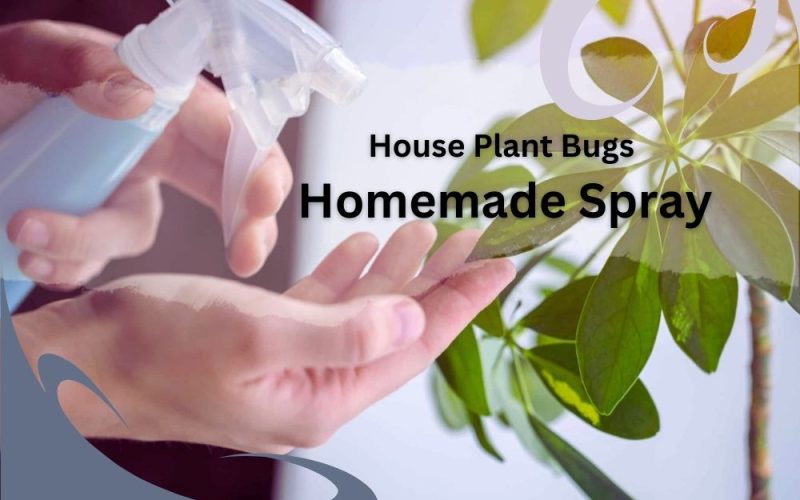Have you spotted tiny bugs on your houseplant and are searching for ways to get rid of them that are safe for your family too? here you will find a comprehensive guideline of house plant bugs homemade spray.

Here, I will first discuss the importance of creating your homemade natural pesticides. After that, I will provide you with the best bug spray for indoor plants and will give you a practical recipe with a lot of pro tips for using them.
Let’s start our journey in the world of Natural pesticides for indoor plants
➡ here you can hear the audio version of this article
Understanding the Need for House Plant Bugs Homemade Spray
Chemical pesticides are usually more effective than natural ones. But why suggest using house plant bugs’ homemade spray for indoor plants? Keep reading to discuss it in this part.

Every gardener has experienced contact with common tiny bugs on houseplants such as aphids, mealybugs, and spider mites on plants. If you don’t control them early they will quickly infest your beloved greenery, causing damage and stress to your plants.
Pesticides are one of the ways that you can get rid of them but which one? Natural or chemical? Keep reading.
Homemade Natural Pesticides: A Safe Alternative
When it comes to pest control for indoor plants, opting for natural homemade remedies has several advantages. These DIY solutions are:
Environmentally Friendly: Chemical pesticides can harm beneficial insects and contaminate the soil. House plant bugs’ homemade spray is eco-friendly and does not harm the environment.
Safe for Pets and Humans: People usually think about adding indoor plants that are safe for kids and pets but what about pesticides? Conventional pesticides can pose health risks to your pets and family members. Homemade sprays are non-toxic and safe.
Cost-Effective: Making your house plant bugs homemade spray is budget-friendly and often uses common household ingredients.
Now, let’s dive into the step-by-step guides for creating homemade natural pesticides to protect your indoor plants.
List of House Plant Bugs Homemade Spray and their recipe
In this part, you will find a list of the most common homemade indoor plant bug sprays with their recipe, and the pro tips to use them. Let start.
1) Soapy Water Spray: A natural pesticide for indoor plants
Soapy water is a simple yet effective remedy for dealing with soft-bodied pests like aphids and mealybugs. One of the best dish soap brands is Dawn, and you can make your homemade bug spray for plants with Dawn.
you also can use it to clean the leaves. Follow the below recipe to make the best ones.
Ingredients:
- 1 tablespoon of liquid dish soap
- 1 quart of water
Instructions:
- Mix the soap and water thoroughly in a spray bottle.
- Spray the solution directly on the affected areas of your plants.
- Repeat every few days until the pests are gone.
Pests Controlled: this house plant bugs homemade spray can control Aphids, mealybugs, spider mites, whiteflies, and soft-bodied insects.
Plant Burn Risk: Low, but prolonged use can affect plant health.
2) Neem Oil Spray: The best bug spray for indoor plants

Neem oil is a powerful house plant bug homemade spray that can deter and kill a wide range of plant pests.
Ingredients:
- 1 tablespoon of neem oil
- 1 quart of warm water
- 1 teaspoon of liquid dish soap (as an emulsifier)
Instructions:
- Combine the neem oil, warm water, and liquid dish soap in a spray bottle.
- Shake well to ensure proper mixing.
- Spray the solution on your plants, targeting both the upper and lower leaf surfaces.
- Apply every 7-14 days for preventive maintenance.
Pests Controlled: Aphids, mealybugs, spider mites, scale insects, fungal diseases and indoor mushrooms. Do you think you must get rid of mushrooms that grow in houseplants? Some people think indoor mushrooms are good luck.
Plant Burn Risk: Low, but avoid using in direct sunlight or on stressed plants.
3) Garlic and Hot Pepper Spray: A homemade plant bug spray
This spicy concoction is excellent for deterring a variety of pests due to its strong odour and flavour.
Ingredients:
- 2 cloves of garlic
- 2 hot peppers
- 1 quart of water
Instructions:
- Crush the garlic cloves and hot peppers.
- Add them to a quart of water and let the mixture sit overnight.
- Strain the liquid and transfer it to a spray bottle.
- Spray your plants with this solution, focusing on areas with pest activity.
Pests Controlled: Aphids, spider mites, ants, and many soft-bodied insects.
Plant Burn Risk: Low, but avoid using on seedlings or young plants.
4) Alcohol Spray: A natural bug spray for plants
Alcohol can help combat pests like mealybugs and scale insects by dissolving their protective coatings.
Ingredients:
- 70% isopropyl alcohol
- A spray bottle
Instructions:
- Pour some isopropyl alcohol into a spray bottle.
- Spray it directly on the pests, avoiding direct contact with the plant.
Pests Controlled: Mealybugs, scale insects, and spider mites.
Plant Burn Risk: Moderate, test on a small area first, and avoid using in direct sunlight.
5) Eucalyptus Oil Spray: A homemade indoor plant bug spray

Eucalyptus oil has a strong scent that repels many garden pests.
Ingredients:
- 1 teaspoon of eucalyptus oil
- 1 quart of water
Instructions:
- Mix the eucalyptus oil and water in a spray bottle.
- Shake well and spray your plants to keep pests at bay.
- Spray on plants every 7-14 days.
Pests Controlled: Aphids, whiteflies, and spider mites.
Plant Burn Risk: Low, but avoid using in direct sunlight.
6) Pepper Spray: One of the Best bug sprays for plants
Pepper spray is a natural deterrent for a wide range of pests.
Ingredients:
- 1 tablespoon of cayenne pepper
- 1 quart of water
Instructions:
- Mix the cayenne pepper and water in a spray bottle.
- Shake well and apply to your plants (affected areas), especially on leaves and stems.
Pests Controlled: this house plant bug homemade spray is useful to control aphids, ants, and soft-bodied insects.
Plant Burn Risk: Low, but avoid using on young plants and flowering houseplants.
7) Chrysanthemum: Natural bug repellent for plants

You may be surprised if I tell you the lovely flowers of Chrysanthemum contain a strong plant chemical compound called pyrethrum. It is a mixture of chemicals toxic to insects that attack their nervous system and immobilize it.
Ingredients:
- Chrysanthemum flowers (dried or fresh)
- A quart of water
Instructions:
- Boil the chrysanthemum flowers in water for about 20 minutes.
- Let the mixture cool and strain it.
- Pour the solution into a spray bottle and apply it to your plants.
- You can add some organic essential oils to improve its odor, however, I’ve never done it.
- Last but not least you should try a spot test on your plant to ensure its reaction.
Pests Controlled: Aphids, spider mites, ants, and many soft-bodied insects.
Plant Burn Risk: Low, but avoid using on young seedlings.
Conclusion
Now you have an ultimate guideline to make your house plant bugs homemade spray. Have you ever experienced Natural bug repellent for plants? Which one? Do you think they work well? My mother uses homemade bug-killer vinegar, I will ask her and add it to the article soon.
Have you ever used a natural bug repellent for plants vinegar? Can you write your recipe below this page? Can you raise our list with other homemade indoor plant bug spray? Please write your experience below this page.
In the following, I answered some of the common questions about “House Plant Bugs Homemade Spray”. Read them and you can also ask your questions below this page. I will answer as soon as possible.
➡ Are homemade plant bug sprays safe for all types of indoor plants?
Yes, these homemade sprays are generally safe for most indoor plants. However, it’s always a good idea to test a small portion of your plant first to ensure there are no adverse reactions.
➡ How often should I apply a house plant bugs homemade spray?
The frequency of application depends on the severity of the pest infestation. In general, it’s recommended to apply the spray every few days until the pests are under control, and then less frequently for preventive maintenance.
➡ Can I use these sprays on edible indoor plants?
Yes, most of the homemade sprays listed here are safe for edible indoor plants. However, make sure to wash edible plants thoroughly before consumption.
➡ Are there any alternatives to house plant bugs homemade spray?
Yes, you can also consider introducing beneficial insects like ladybugs or using organic commercial pest control products as alternatives.
➡ Where can I purchase the ingredients for these homemade sprays?
You can find most of the ingredients in local grocery stores, gardening centres, or online retailers. Ensure you choose high-quality, organic ingredients for the best results.

Elahe Rabiei
Hi, I’m Elaheh. My Academic major is plant protection, and houseplants are my expertise. As a houseplant lover, my house is full of indoor plants and it is my passion to take care of them. Hence, I’m here to share my knowledge and experience about growing healthy houseplants. I am also a plant protection advisor, so feel free to ask me any questions you may have.

